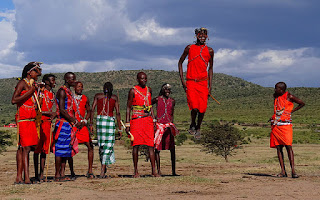 |
| Portuguese Chapel in Malindi, Kenya https://commons.wikimedia.org/wiki/File:Portuguese_chapel_02.JPG |
The first known missionary to Kenya was John Ludwig Krapf of the Church Missionary Society. (3) A German, Protestant Christian missionary, Krapf first came to Mombasa, Kenya in 1844. (3) Krapf translated the New Testament into a local language for the people, and encouraged Methodists to try to evangelize to the people of Kenya. (4)
 |
| Route of missionary John Krapf in Kenya https://upload.wikimedia.org/wikipedia/commons/2/2c/Routes_of_European_explorers_in_Africa%2C_to_1853.jpg |
Other Christian missionary groups to Kenya over the next hundred years included the Presbyterian East African Scottish Mission, the United Methodist Free Churches Mission, the English Society of Friends, the interdenominational Africa Inland Mission, and the Pentecostal Gospel Missionary Society. (5) As for Catholic missionaries, there were two main groups that reached out to Kenya.
The First, the French Congregation of the Holy Ghost, expanded to Kenya in 1899. (6) The Consolata Mission spread to Kenya in 1903 as a result of the Institute Mission Consolata, an institute for training missionaries. (7) Many of these organizations instituted churches in and around Kenya.
 |
| A missionary from Church of Scotland teaching a cooking lesson https://commons.wikimedia.org/wiki/File:Cooking_Lesson,_Kenya,_ca.1905-ca.1940_(imp-cswc-GB-237-CSWC47-LS7-033).jpg |
As of 2008, 80% of the population of Kenya identify as Protestant Christian or Roman Catholic. (11) As one can see from this large percentage, the Christian and Catholic missionaries had a large impact of the people of Kenya, whether directly or indirectly through the encouragement of the foundation of indigenous churches. Without the work of these missionaries, the religious make-up of the nation would look much different.
(1) "The Beginning and Development of Christianity in Kenya: A Survey", The Portuguese Period, http://www.dacb.org/history/beginning%20and%20development%20of%20christianity%20in%20kenya.html.
(2) "The Beginning and Development of Christianity in Kenya: A Survey", The Portuguese Period, http://www.dacb.org/history/beginning%20and%20development%20of%20christianity%20in%20kenya.html, ¶ 11-12.
(3) "The Beginning and Development of Christianity in Kenya: A Survey", Modern Missionary Movement: The Protestant Missions, http://www.dacb.org/history/beginning%20and%20development%20of%20christianity%20in%20kenya.html, ¶ 3-4.
(4) "The Beginning and Development of Christianity in Kenya: A Survey", Modern Missionary Movement: The Protestant Missions, http://www.dacb.org/history/beginning%20and%20development%20of%20christianity%20in%20kenya.html, ¶ 5-6.
(5) "The Beginning and Development of Christianity in Kenya: A Survey", Modern Missionary Movement: The Protestant Missions, http://www.dacb.org/history/beginning%20and%20development%20of%20christianity%20in%20kenya.html, ¶ 12-18.
(6) "The Beginning and Development of Christianity in Kenya: A Survey", Modern Missionary Movement: Roman Catholic Missions, http://www.dacb.org/history/beginning%20and%20development%20of%20christianity%20in%20kenya.html, ¶ 1-3.
(7) "The Beginning and Development of Christianity in Kenya: A Survey", Modern Missionary Movement: Roman Catholic Missions, http://www.dacb.org/history/beginning%20and%20development%20of%20christianity%20in%20kenya.html, ¶ 4.(6) "The Beginning and Development of Christianity in Kenya: A Survey", Modern Missionary Movement: Roman Catholic Missions, http://www.dacb.org/history/beginning%20and%20development%20of%20christianity%20in%20kenya.html, ¶ 1-3.
(8) "The Beginning and Development of Christianity in Kenya: A Survey", From Mission to Church,http://www.dacb.org/history/beginning%20and%20development%20of%20christianity%20in%20kenya.html, ¶ 1-2.
(9) "The Beginning and Development of Christianity in Kenya: A Survey", From Mission to Church,http://www.dacb.org/history/beginning%20and%20development%20of%20christianity%20in%20kenya.html, ¶ 1-7.
(10) "The Beginning and Development of Christianity in Kenya: A Survey", From Mission to Church,http://www.dacb.org/history/beginning%20and%20development%20of%20christianity%20in%20kenya.html, ¶ 6.
(11) (1) "International Religious Freedom Report", Section I. Religious Demography, http://www.state.gov/j/drl/rls/irf/2008/108374.htm, ¶ 1.









